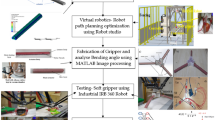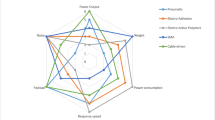Abstract
In order to realize the compliant grinding and polishing of complex surfaces, the traditional impedance control cannot adjust the system impedance, so the force tracking deviation is large, the adaptive variable impedance control can adapt to the environmental changes to adjust the system impedance and realize the stable tracking of the contact force, but the overshoot is too large. In this paper, the constant force control of compliant grinding and polishing processing is studied on the designed macro-mini robotic system, and an adaptive variable impedance control algorithm with pre-PD adjustment is proposed. The control law is used to update the damping term in the impedance parameters of the system, and realize the constant force control process in which the grinding and polishing head is approximately perpendicular to the machined surface, and the stability and convergence of the force control algorithm are proved. Through simulation and experiment, the four algorithms of impedance control, adaptive impedance control, adaptive variable impedance control and the proposed PD-adaptive variable impedance control are compared and analyzed in the force tracking performance of plat surface, sloped surface and curved surface, and then in the grinding and polishing experiments to verify the grinding and polishing force tracking error, the force tracking errors of the other three control algorithms are controlled within 2.08 N, 1.30 N, and 1.34 N, and the overshoot amounts to 19.2%, 56.3%, and 11.1%. The proposed algorithm can control the force tracking error within 0.78 N, the overshoot is less than 4.5%, which verifies that the proposed force control algorithm is more superior in force control performance and is suitable for force control scenarios of actual grinding and polishing.

















Similar content being viewed by others
Data availability
The data of this study are available from the first author or corresponding author upon reasonable request.
Abbreviations
- x, mm:
-
Offline trajectory
- θ d , rad:
-
Desired angle value of the six-axis joint of the robot
- θ c , rad:
-
Actual control angle value of the six-axis joint of the robot
- θ m , rad:
-
Actual angle value of the six-axis joint of the robot
- ∆f, N:
-
Force error
- f r , N:
-
Expected contact force
- f e , N:
-
Actual contact force
- k e , N/m:
-
Environmental stiffness
- m d , kg:
-
Mass coefficient
- ∆b, N/(m/s):
-
Damping compensation coefficient
- b d , N/(m/s):
-
Damping coefficient
- x m , mm:
-
Displacement obtained by the positive kinematics of the robot
- x r , mm:
-
Motion reference trajectory
- x e , mm:
-
Actual environmental position
- e, mm:
-
Position error
- \(\widehat{{e}}\) , mm:
-
Estimated position error
- f r ’, N:
-
Variable contact force
- \({\widehat{{x}}}_{{e}}\), mm:
-
Estimated environmental position
- \({\widehat{e}}_{{ss}}\) , ——:
-
Steady-state error
- e 1, mm:
-
Calculated desired displacement
- e 2 , mm:
-
Specified displacement of the voice coil motor movement
- e 3 , mm:
-
Actual displacement of the voice coil motor movement
- x d , mm:
-
Actual displacement of the end effector
- M d , Kg:
-
Mass coefficient matrix
- B d , N/(m/s):
-
Damping coefficient matrix
- K d , N/m:
-
Stiffness coefficient matrix
- F e , N:
-
Actual contact force matrix
- F r , N:
-
Expected contact force matrix
- X d , mm:
-
Actual displacement matrix of the end effector
- k d , N/m:
-
Stiffness coefficient
- X r , mm:
-
Expected environmental position matrix
- η, ——:
-
Sampling time of the controller
- σ, ——:
-
Update rate
- λ, ——:
-
Adjustment control parameter
- k p1 , ——:
-
Contact force coefficient
- k d1 , ——:
-
Contact force error coefficient
- \(\delta {{x}}_{{e}}\), mm:
-
Environmental position disturbance
- v e, mm/s:
-
Speed of the macro-robot
References
Hong J, Mohammad AEK, Wang D (2017) Improved design of the end-effector for macro-mini robotic polishing systems. In: Proceedings of 2017 3rd International Conference on Mechatronics and Robotics Engineering (ICMRE 2017), pp 36–41. https://doi.org/10.1145/3068796.3068809
Tian F, Lv C, Li Z, Liu G (2016) Modeling and control of robotic automatic polishing for curved surfaces. CIRP J Manuf Sci Technol 14:55–64. https://doi.org/10.1016/j.cirpj.2016.05.010
Shi T, Zheng D, Wang S, Li H (2011) Polishing force control in precise NC polishing of aspheric parts. Opt Precis Eng 19(05):1013–1021. https://doi.org/10.3788/OPE.20111905.1013
Liu CH, Chen CCA, Huang JS (2005) The polishing of molds and dies using a compliance tool holder mechanism. J Mater Process Technol 166(2):230–236. https://doi.org/10.1016/j.jmatprotec.2004.08.021
Dai J, Chen CY, Zhu R, Yang G, Wang C, Bai S (2021) Suppress vibration on robotic polishing with impedance matching. Actuators 10(3):59. https://doi.org/10.3390/act10030059
Sharon A, Hardt D (1984) Enhancement of robot accuracy using endpoint feedback and a macro-mini manipulator system. In: Proceedings of the 1984 American Control Conference (IEEE 1984), pp 1836–1845. https://doi.org/10.23919/acc.1984.4788550
Li J, Guan Y, Chen H, Wang B, Zhang T, Liu X, Hong J, Wang D, Zhang H (2020) A high-bandwidth end-effector with active force control for robotic polishing. IEEE Access 8:169122–169135. https://doi.org/10.1109/ACCESS.2020.3022930
Huang T, Sun L, Wang Z, Yu X, Chen G (2017) Hybrid force/position control method for robotic polishing based on passive compliance structure. Robot 39(6):776–785. https://doi.org/10.13973/j.cnki.robot.2017.0776
Wei Y, Xu Q (2022) Design of a new passive end-effector based on constant-force mechanism for robotic polishing. Comput Integr Manuf 74:102278. https://doi.org/10.1016/j.rcim.2021.102278
Ma Z, See HH, Hong GS, Ang MH, Poo AN, Lin W, Tao PYand Short JS (2017) Control and modeling of an end-effector in a macro-mini manipulator system for industrial applications. In: Proceedings of the 2017 IEEE International Conference on Advanced Intelligent Mechatronics (AIM 2017), pp 676–681. https://doi.org/10.1109/AIM.2017.8014095
Liu X, Zhang T, Li J, Guan Y, Liu G (2018) A novel end-effector for robotic compliant polishing. In: Proceedings of the 2018 IEEE International Conference on Robotics and Biomimetics (ROBIO 2018), pp 1858–1863. https://doi.org/10.1109/ROBIO.2018.8665197
Mohammad AEK, Hong J, Wang D (2018) Design of a force-controlled end-effector with low-inertia effect for robotic polishing using macro-mini robot approach. Robot Comput-Integr Manuf 49:54–65. https://doi.org/10.1016/j.rcim.2017.05.011
Dong J, Shi J, Liu C, Yu T (2021) Research of pneumatic polishing force control system based on high speed on/off with PWM controlling. Robot Comput-Integr Manuf 70:102133. https://doi.org/10.1016/j.rcim.2021.102133
Yang G, Zhu R, Fang Z, Chen CY, Zhang C (2020) Kinematic design of a 2R1T robotic end-effector with flexure joints. IEEE Access 8:57204–57213. https://doi.org/10.1109/ACCESS.2020.2982185
Li J, Guan Y, Chen H, Wang B, Zhang T, Hong J, Wang D (2022) Real-time normal contact force control for robotic surface processing of workpieces without a priori geometric model. Int J Adv Manuf Technol 119:2537–2551. https://doi.org/10.1007/s00170-021-07497-2
Chen F, Zhao H, Li D, Chen L, Tan C, Ding H (2019) Robotic grinding of a blisk with two degrees of freedom contact force control. Int J Adv Manuf Technol 101:461–474. https://doi.org/10.1007/s00170-018-2925-6
Ma Z, Poo AN, Ang MH (2018) Design and control of an end-effector for industrial finishing applications. Robot Comput-Integr Manuf 53:240–253. https://doi.org/10.1016/j.rcim.2018.04.010
Ding B, Zhao J, Li Y (2021) Design of a spatial constant-force end-effector for polishing/deburring operations. Int J Adv Manuf Technol 116:3507–3515. https://doi.org/10.1007/s00170-021-07579-1
Xu X, Huang Z, Wang Y, Hai L, Xiang C (2020) A novel force-controlled spherical polishing tool combined with self-rotation and co-rotation motion. IEEE Access 8:108191–108200. https://doi.org/10.1109/ACCESS.2997968
Ogawa S, Koto K, Tsukada T, Kakinuma Y (2021) Enhancement of force control performance of macro-mini system based polishing robot with gravity compensation. In: Proceedings of the ASME 2021 16th International Manufacturing Science and Engineering Conference (MSEC 2021). https://doi.org/10.1115/MSEC2021-63720
Dai J, Chen CY, Zhu R, Yang G, Wang C, Bai S (2021) An active vibration suppression method for macro-mini manipulator. In: Proceedings of the 2021 IEEE 11th Annual International Conference on CYBER Technology in Automation, Control, and Intelligent Systems (CYBER 2021), pp 158–162. https://doi.org/10.1109/CYBER53097.2021.9588199
Hogan N (1985) Impedance control: an approach to manipulation: part I-Theory. J Dyn Sys Meas Control 107(1):1–7. https://doi.org/10.1115/1.3140702
Baigzadehnoe B, Rahmani Z, Khosravi A, Behrooz R (2017) On position/force tracking control problem of cooperative robot manipulators using adaptive fuzzy backstepping approach. ISA Trans 70:432–446. https://doi.org/10.1016/j.isatra.2017.07.029
Seraji H, Colbaugh R (1997) Force tracking in impedance control. Int J Rob Res 16(1):97–117. https://doi.org/10.1177/027836499701600107
Zhang X, Khamesee MB (2017) Adaptive force tracking control of a magnetically navigated microrobot in uncertain environments. IEEE ASME Trans Mechatron 22(4):1644–1651. https://doi.org/10.1109/TMECH.2017.2705523
Kronander K, Billard A (2016) Stability considerations for variable impedance control. IEEE Trans Robot 32(5):1298–1305. https://doi.org/10.1109/TRO.2016.2593492
Xu K, Wang S, Yue B, Wang J, Peng H, Liu D, Chen Z, Shi M (2020) Adaptive impedance control with variable target stiffness for wheel-legged robot on complex unknown terrain. Mechatronics 69:102388. https://doi.org/10.1016/j.mechatronics.2020.102388
Dong J, Xu J, Zhou Q, Hu S (2020) Physical human-robot interaction force control method based on adaptive variable impedance. J Franklin Inst 357(12):7864–7878. https://doi.org/10.1016/j.jfranklin.2020.06.007
Li C, Zhang Z, Xia G, Xie X, Zhu Q (2019) Efficient learning variable impedance control for industrial robots. Bull Pol Acad Sci: Tech Sci 67(2):201–212. https://doi.org/10.24425/bpas.2019.128116
Duan J, Gan Y, Chen M, Dai X (2018) Adaptive variable impedance control for dynamic contact force tracking in uncertain environment. Rob Auton Syst 102:54–65. https://doi.org/10.1016/j.robot.2018.01.009
Cao H, Chen X, He Y, Zhao X (2019) Dynamic adaptive hybrid impedance control for dynamic contact force tracking in uncertain environments. IEEE Access 7:83162–83174. https://doi.org/10.1109/ACCESS.2019.2924696
Cao H, Chen X, He Y, Zhao X (2020) Smooth adaptive hybrid impedance control for robotic contact force tracking in dynamic environments. Ind Rob 47(2):231–242. https://doi.org/10.1108/IR-09-2019-0191
Pei Y, Obinata G, Kim Y, Lee J (2015) Adaptive impedance control with variable viscosity for motion and force tracking system. In: Proceedings of the 2015 International Symposium on Micro-NanoMechatronics and Human Science (MHS 2015). https://doi.org/10.1109/MHS.2015.7438279
Grafakos S, Dimeas F, Aspragathos N (2016) Variable admittance control in pHRI using EMG-based arm muscles co-activation. In: Proceedings of the 2016 IEEE International Conference on Systems, Man, and Cybernetics (SMC 2016), pp 1900–1905. https://doi.org/10.1109/SMC.2016.7844516
He W, Dong Y (2017) Adaptive fuzzy neural network control for a constrained robot using impedance learning. IEEE Trans Neural Netw Learn Syst 29(4):1174–1186. https://doi.org/10.1109/TNNLS.2017.2665581
Hamedani MH, Sadeghian H, Zekri M, Sheikholeslam F, Keshmiri M (2021) Intelligent impedance control using wavelet neural network for dynamic contact force tracking in unknown varying environments. Control Eng Pract 113:104840. https://doi.org/10.1016/j.conengprac.2021.104840
Du Z, Wang W, Yan Z, Dong W, Wang W (2017) Variable admittance control based on fuzzy reinforcement learning for minimally invasive surgery manipulator. Sensors 17(4):844. https://doi.org/10.3390/s21051899
Li C, Zhang Z, Xia G, Xie X, Zhu Q (2018) Efficient force control learning system for industrial robots based on variable impedance control. Sensors 18(8):2539. https://doi.org/10.3390/s18082539
Zhou H, Ma S, Wang G, Deng Y, Liu Z (2021) A hybrid control strategy for grinding and polishing robot based on adaptive impedance control. Adv Mech Eng 13(3):168781402110040. https://doi.org/10.1177/16878140211004034
Funding
This work was supported by National Key R&D Program of China (2018YFB1308900), the Key Project of Tianjin Applied Basic Research Multi-Investment Fund Project (21JCZDJC00870), and Tianjin Postgraduate Research and Innovation Project (2021YJSS094).
Author information
Authors and Affiliations
Contributions
Guilian Wang: resources, instructing, review; Yuxin Deng: conceptualization, writing original draft, validation; Haibo Zhou: instructing, review; Xu Yue: methodology.
Corresponding author
Ethics declarations
Conflict of interest
The authors declare no competing interests.
Additional information
Publisher’s note
Springer Nature remains neutral with regard to jurisdictional claims in published maps and institutional affiliations.
Rights and permissions
Springer Nature or its licensor (e.g. a society or other partner) holds exclusive rights to this article under a publishing agreement with the author(s) or other rightsholder(s); author self-archiving of the accepted manuscript version of this article is solely governed by the terms of such publishing agreement and applicable law.
About this article
Cite this article
Wang, G., Deng, Y., Zhou, H. et al. PD-adaptive variable impedance constant force control of macro-mini robot for compliant grinding and polishing. Int J Adv Manuf Technol 124, 2149–2170 (2023). https://doi.org/10.1007/s00170-022-10405-x
Received:
Accepted:
Published:
Issue Date:
DOI: https://doi.org/10.1007/s00170-022-10405-x




